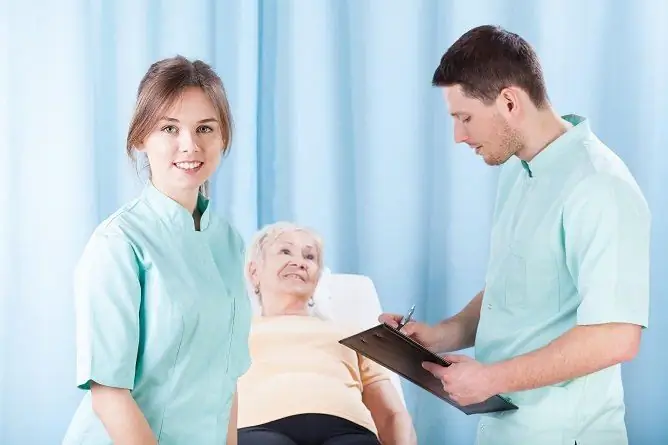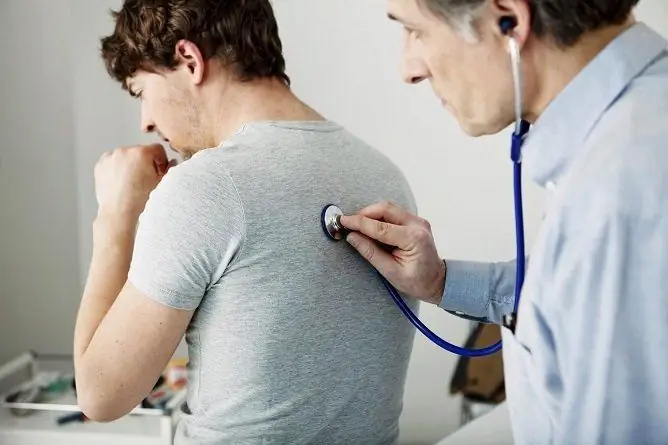Congestive pneumonia in bedridden patients: treatment, symptoms, prevention
The content of the article:
-
The reasons
Trigger factors
-
Symptoms
- Signs of manifest bilateral pneumonia
- Extrapulmonary symptoms of pneumonia
- Asymptomatic course of pathology
- Diagnostics
-
Treatment
- Purpose of therapy
- Antibiotic therapy
- Ancillary methods of drug therapy
- Traditional methods of treating pneumonia at home
-
Prevention
Respiratory gymnastics as a method of preventing congestive pneumonia
- Forecast
- Video
Pneumonia in bedridden patients in most cases is a consequence of stagnation of blood in the pulmonary circulation. Symptoms of early hypostatic pneumonia are often masked by signs of an underlying pathology (heart attack, stroke, heart failure), so it is very difficult to recognize the disease.

Pneumonia in bedridden patients is difficult to diagnose
Treatment of pathology is difficult, since most often the patient has many pathological changes in the internal organs. Due to low mobility, there is a violation of blood supply and, as a result, swelling and bedsores.
Congestive pneumonia in bedridden patients may be:
- early: occurs in the first days of bed rest;
- late: symptoms appear 4–6 weeks after the patient becomes bedridden.
Since the diagnosis of pneumonia is difficult, and antibiotics often do not give the desired effect, the prognosis is poor. The rapid transition from the initial stage to the terminal stage can be fatal.
The reasons
An important role in the act of breathing is played by the movements of the chest during inhalation and exhalation. If the patient is in the supine position for a long time, the chest amplitude during breathing is limited.
Breathing is reflexive and regulated by the respiratory center, which is located in the brain. Due to the lowering of the diaphragm and contraction of the external intercostal muscles, the chest expands, and negative pressure is created in the chest cavity.

The main function of the lungs is to provide gas exchange between alveolar air and blood
This allows the alveoli to fill with air and creates blood flow into the pulmonary arteries. Gas exchange occurs in the alveoli, oxygen enters the blood, and carbon dioxide is removed from the blood into the lumen.
Normally, after gas exchange, a full exhalation occurs. At this point, the diaphragm relaxes and the internal intercostal muscles contract. As a result, there is a reduction in the volume of the chest cavity and the expulsion of air and oxygenated blood from the pulmonary circulation. Dust and mucus come out with the air.
In a lying person, this process is disrupted, due to defective respiratory movements in the pulmonary vessels, blood stagnates, and mucus and dust accumulate in the lungs. This becomes a prerequisite for the development of the inflammatory process.

When breathing, chest movements play an important role
Also, due to the weakening of local immunity, pathogenic microorganisms that enter the body can begin to actively multiply, as a result of which the patient may develop viral, bacterial or fungal pneumonia.
Trigger factors
Factors affecting the development of the disease:
- elderly age of the patient (over 60 years old);
- cardiovascular diseases;
- chronic diseases of the bronchopulmonary system;
- immunity disorders;
- being in one position for a long period;
- violation of personal hygiene rules.
Symptoms
The following symptoms indicate the development of congestive pneumonia in bedridden patients:
- prolonged unproductive cough, in which phlegm is poorly released;
- shortness of breath that occurs when lying down;
- a crunchy sound that occurs when breathing (pleural crepitation);
- pain in the chest with inflammation of the pulmonary parenchyma;
- increase in body temperature to 37.0–37.5 ° С;
- lack of appetite;
- weakness and apathy.

One of the symptoms of pneumonia is an increase in body temperature
The patient has dry wheezing that can be heard when listening with a stethoscope. A finger examination of the chest wall reveals a shortening of the percussion sound.
Signs of manifest bilateral pneumonia
If treatment is not started in a timely manner, pneumonia turns into a manifesting bilateral form, while the patient develops symptoms such as:
- severe shortness of breath;
- wet wheezing;
- increase in body temperature to 39.0–40.0 ° С;
- prolonged cough with an abundance of mucopurulent sputum.
In some cases, the patient has hemoptysis, which is a very unfavorable sign. In addition, the patient has severe symptoms of intoxication, including chills, sweating, nausea, vomiting, and confusion.
Extrapulmonary symptoms of pneumonia
In addition to the main signs of the disease, almost 75% of elderly bedridden patients have extrapulmonary symptoms of the disease:
| Body system | Symptoms |
| Digestive system | Nausea, vomiting, abdominal pain, lack of appetite |
| The cardiovascular system | Arrhythmia, tachycardia, congestion in the lower extremities |
| Nervous system | Headache, dizziness, confusion, lethargy, drowsiness |
| urinary system | Back pain, difficulty or uncontrolled urination |
The appearance of extrapulmonary symptoms of the disease aggravates the patient's condition and makes the prognosis even more unfavorable.
Asymptomatic course of pathology
In bedridden patients, pneumonia is very often almost asymptomatic. The patient may have only mild shortness of breath, which is attributed to the weakening of the body. Inflammation of the lungs in the elderly rapidly progresses from an initial stage to bilateral infiltration of alveolar tissue.
This is complicated by the fact that the doctor cannot correctly interpret the data he receives when tapping and listening with a phonendoscope. In addition, in bedridden elderly patients, as a result of tissue scarring, pneumosclerosis of the pulmonary parenchyma develops.
Diagnostics
The disease can be diagnosed by a doctor who treats the underlying pathology (pulmonologist, cardiologist, neurologist, therapist, traumatologist). He collects anamnesis and prescribes the following examinations:
- a general blood test (with infectious pneumonia, ESR and the number of leukocytes increase);
- X-rays of light;
- blood chemistry;
- bacterial culture of sputum;
- Analysis of urine;
- bronchoscopy;
- tomography of the lungs.

A doctor who treats the underlying pathology of a bed patient can diagnose pneumonia
Treatment
Purpose of therapy
Treatment goals for congestive pneumonia are:
- elimination of the infection that caused the disease;
- removal of exudate from the lungs;
- elimination of congestion in the lungs;
- restoration of the drainage function of the bronchi;
- stimulation of immunity.
Antibiotic therapy
Treatment of pathology in bedridden patients is carried out with antibiotics. The patient is prescribed drugs of the following groups:
| Antibiotic groups | Drug names |
| Penicillins | Benzylpenicillin, Amoxicillin, Augmentin, Amoxiclav, Amoxil |
| Cephalosporins | Emssef, Ceftriaxone, Cefazolin, Efmerin |
| Macrolides | Azithromycin, Clarithromycin (usually prescribed in combination with penicillins) |
Antibiotics are initially given by intramuscular or intravenous injection. In severe forms of the disease, solutions are used in the form of droppers. After 3-4 days, after the patient's condition improves, the patient is transferred to antibiotics in the form of tablets or suspension. The course of treatment is 2-3 weeks.
Ancillary methods of drug therapy
To reduce body temperature and reduce pain, non-steroidal anti-inflammatory drugs based on ibuprofen, nimesulide or paracetamol are prescribed. They are used in the form of tablets or solutions 2-3 times a day after meals.

In addition to antibiotics, symptomatic drugs are prescribed.
With severe intoxication, detoxification solutions are shown: Reosorbilact, Reopolyglucin. Saline solutions or glucose are also used.
Treat swelling and reduce inflammation with corticosteroids. Hormonal drugs (Dexamethasone, Prednisolone) are used in the form of tablets or injections. In severe cases, they are administered intravenously.
Traditional methods of treating pneumonia at home
In the complex treatment of the disease, folk remedies are used:
- decoction of flax seeds. To prepare the product, two tablespoons of dry raw materials are poured into 1 liter of water and boiled over low heat for at least 5 minutes. Then the broth is removed from the heat, poured into a thermos and left for 5-6 hours. Take the product 100 ml 4 times a day. The treatment lasts until the patient's condition improves;
- decoction of parsley seeds. One tablespoon of plant seeds is poured into 1/2 liter of water and boiled over low heat for 20 minutes. After the product has cooled down, filter it and take one tablespoon 4 times a day;
- decoction of lovage roots. To prepare it, 50 g of dry raw materials are poured into 1 liter of water and boiled for 10 minutes. In the future, the agent is insisted in a warm place for 2 hours. Filter and consume 50 ml three times a day before meals;
- infusion of viburnum. To prepare it, 1/2 cup of fresh viburnum berries are poured into 1 liter of boiling water and insisted for 5 hours. Then the agent is filtered and given to the patient 200 ml three times a day. Honey can be added to improve the taste;
- a mixture of sea buckthorn with honey. A glass of sea buckthorn berries is crushed using a blender and the same amount of honey is added. The patient is given one tablespoon of the remedy three times a day before meals.
Prevention
Bedridden patients need to pay special attention to methods of preventing the development of pneumonia:
- give a half-sitting position;
- change body position at least 4 times a day;
- do massage (cupping, percussion).

It is important to try to give the patient a semi-sitting position.
In order to prevent the development of congestive pneumonia, you need to monitor the patient's diet. His diet should have a sufficient amount of vitamins and minerals. If a person has a poor appetite, vitamin complexes are shown to him.
Respiratory gymnastics as a method of preventing congestive pneumonia
Another method of preventing congestive pneumonia is breathing exercises. This is a vital procedure on which rehabilitation depends.
Respiratory gymnastics has a general tonic effect, has a positive effect on the patient's mental state, and also allows:
- prevent lung muscle atrophy;
- restore lung function after an illness;
- stimulate the functions of the cardiovascular system;
- prevent the occurrence of blood clots and the development of pathologies of the urinary system.
In order to prevent the development of congestive pneumonia, the patient must perform the following exercises:
- while inhaling, the patient raises his arms up and hugs his shoulders, and on exhalation returns to its original position (performed lying on his back);
- the patient, while inhaling, raises his hands with his palms up, while exhaling, he lowers them along the body;
- the patient performs head turns in both directions simultaneously with short inhalation and exhalation;
- the patient clenches his hands into fists and puts them to the belt, when inhaling, he sharply lowers him down, and when he exhales, he returns to the starting position.
Inflating balloons, blowing air into a tube placed in a glass of water (allows ventilation of the lower lungs) also have a good effect.
Forecast
The prognosis for developing congestive pneumonia depends on which part of the lungs is affected by the inflammatory process, what exactly caused the disease and at what stage the inflammation was detected. The presence of concomitant pathologies is also taken into account.
If the disease is detected on time, and the prescribed treatment gives the desired effect, then the prognosis is favorable. In severe forms of the disease, a lethal outcome is possible. Therefore, if you suspect the development of congestive pneumonia, it is necessary to show the lying patient to the doctor as soon as possible.
Video
We offer for viewing a video on the topic of the article.

Anna Kozlova Medical journalist About the author
Education: Rostov State Medical University, specialty "General Medicine".
Found a mistake in the text? Select it and press Ctrl + Enter.







